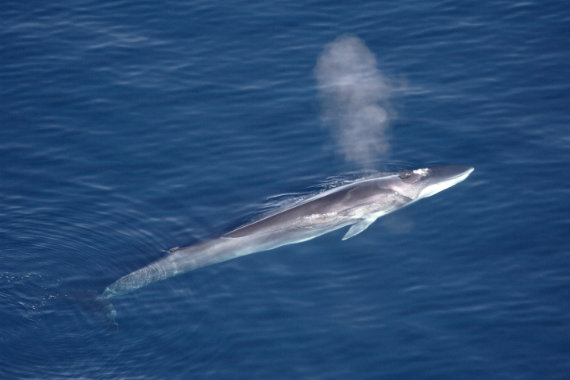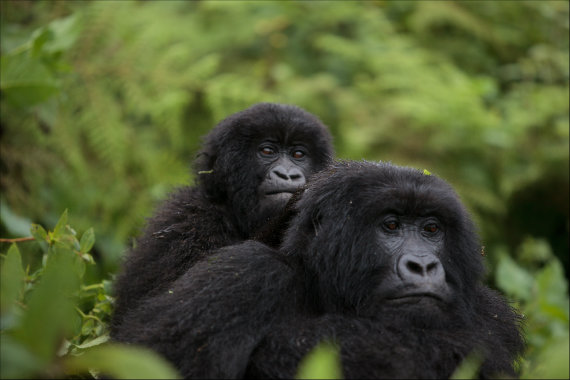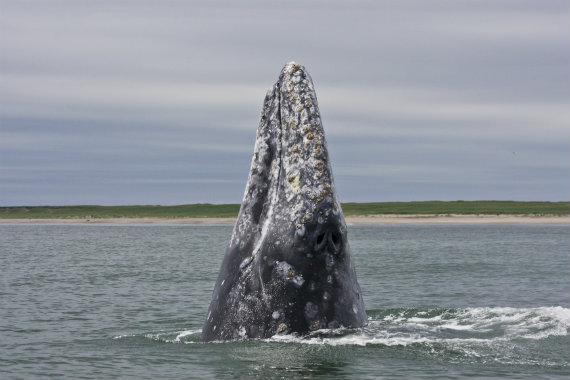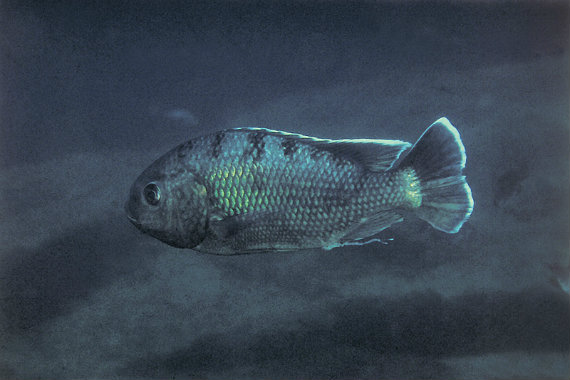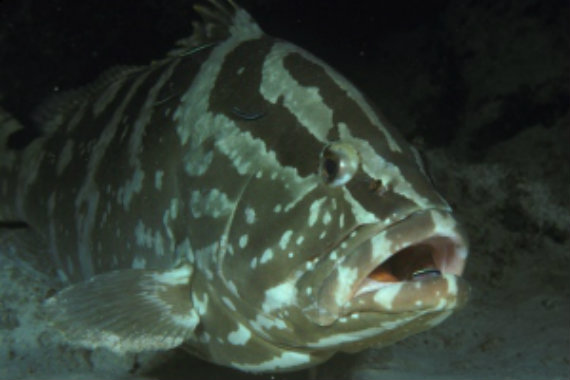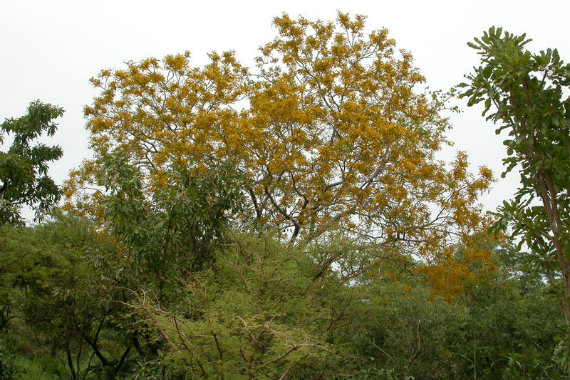Fin Whale, Mountain Gorilla recovering thanks to conservation action – IUCN Red List
Gland, Switzerland, 14 November 2018 (IUCN) – Conservation action has brought renewed hope for the Fin Whale and the Mountain Gorilla, according to today’s update of The IUCN Red List of Threatened Species. The Fin Whale has improved in status from Endangered to Vulnerable following bans on whaling, while the Mountain Gorilla subspecies has moved from Critically Endangered to Endangered thanks to collaborative conservation efforts.
Today’s IUCN Red List update also reveals that overfishing is causing fish species in parts of the developing world to decline, with 13% of the world’s grouper species and 9% of Lake Malawi fish now threatened with extinction. Overexploitation also threatens the Vene tree (Pterocarpus erinaceus) – an important source of timber – which enters The IUCN Red List as Endangered.
The IUCN Red List now includes 96,951 species of which 26,840 are threatened with extinction.
“Today’s update to The IUCN Red List illustrates the power of conservation action, with the recoveries we are seeing of the Fin Whale and the Mountain Gorilla,” says Inger Andersen, IUCN Director General. “These conservation successes are proof that the ambitious, collaborative efforts of governments, business and civil society could turn back the tide of species loss. Unfortunately, the latest update also underlines how threats to biodiversity continue to undermine some of society’s most important goals, including food security. We urgently need to see effective conservation action strengthened and sustained. The ongoing UN biodiversity summit in Egypt provides a valuable opportunity for decisive action to protect the diversity of life on our planet.”
Whale populations on the rise
Previously listed as Endangered, the Fin Whale (Balaenoptera physalus) is now listed as Vulnerable as the global population of the species has roughly doubled since the 1970s. The recovery follows international bans on commercial whaling in the North Pacific and in the Southern Hemisphere, in place since 1976, and significant reductions in catches in the North Atlantic since 1990. The status of the western subpopulation of the Gray Whale (Eschrichtius robustus) has also improved, moving from Critically Endangered to Endangered. Both of these whale species were historically threatened by overexploitation for their blubber, oil and meat.
“Fin Whales and Western Gray Whales were severely depleted by hunting, and it is a relief to finally see their populations on the rise. These whales are recovering largely thanks to bans on commercial hunting, international agreements and various protection measures. Conservation efforts must continue until the populations are no longer threatened,” says Randall Reeves, Chair of the IUCN SSC Cetacean Specialist Group. “These examples of governments, industry and civil society acting together for conservation should provide inspiration for Parties gathering in Egypt this week at the Convention on Biological Diversity conference.”
The nearly complete protection of Fin Whales throughout their range has allowed the global population to reach around 100,000 mature individuals. Western Gray Whales have been protected from commercial whaling in almost all range state since 1980, but only recently has there been clear evidence of increasing numbers in the western Pacific, particularly off Sakhalin Island, Russia. The delay between conservation measures taking effect and the detection of whale recovery is due, in part, to these animals’ slow rate of reproduction. Five Gray Whale range states – Japan, the Russian Federation, the Republic of Korea, the USA and Mexico – have signed a Memorandum of Cooperation Concerning Conservation Measures for the Western Gray Whale Population. Industrial activity including oil and gas development and commercial fisheries also represent a potential threat to Gray Whales. Since 2004, an IUCN-led independent panel of scientists has been advising Sakhalin Energy, one of the largest companies operating offshore in the Russian Far East, on how to manage the potential impacts of its activities on the whales.
Hope for the Mountain Gorilla
This update of The IUCN Red List also brings hope for the Mountain Gorilla (Gorilla beringei beringei), which has improved in status from Critically Endangered to Endangered thanks to collaborative conservation efforts across country boundaries and positive engagement from communities living around the Mountain Gorilla habitat. The Mountain Gorilla is one of two subspecies of the Eastern Gorilla (Gorilla beringei); the Eastern Gorilla species remains Critically Endangered.
Intensive conservation action, including anti-poaching patrols and in-situ veterinary interventions – such as the removal of snares – has contributed to the growth of Mountain Gorilla populations since the previous IUCN Red List assessment, published in 2008. The 2008 Mountain Gorilla population was estimated to be around 680 individuals, but 2018 estimates show that it has increased to over 1,000 individuals, the highest figure ever recorded for the subspecies. The population growth has been confirmed through coordinated and improved survey methods.
Mountain Gorilla habitat is restricted to protected areas covering approximately 792 km2 in two locations in the Democratic Republic of the Congo, Rwanda and Uganda – the Virunga Massif and Bwindi-Sarambwe. Both locations are bordered by land intensively cultivated for agriculture by a growing human population. Threats to this subspecies remain high, including poaching, recurring civil unrest and human-introduced diseases, ranging from respiratory infections to Ebola.
“Whilst it is fantastic news that Mountain Gorillas are increasing in number, this subspecies is still Endangered and therefore conservation action must continue,” says Dr Liz Williamson of the IUCN SSC Primate Specialist Group. “Coordinated efforts through a regional action plan and fully implementing IUCN Best Practice guidelines for great ape tourism and disease prevention, which recommend limiting numbers of tourists and preventing any close contact with humans, are critical to ensuring a future for the Mountain Gorilla.”
Fish species threatened by overfishing
Fifty-four fish species from two important fisheries are threatened by unsustainable fishing, according to The IUCN Red List update.
Nine per cent of the 458 fish species assessed in Lake Malawi are at high risk of extinction, causing concern for regional food security. Three out of the four species of Chambo (Oreochromis karongae, Oreochromis squamipinnis, Oreochromis lidole) – Malawi’s most economically valuable fish – are Critically Endangered. Chambo fisheries are now on the brink of collapse. Over one-third of Malawians depend on Lake Malawi, Africa’s third largest lake, for their food and livelihoods. Similar findings were highlighted in a recent report from the Lake Victoria Basin, where three quarters of all endemic freshwater species are threatened. Local livelihoods in several East African countries dependent on resources from these lakes are threatened by unsustainable fishing.
The first reassessment of all 167 species of grouper – an economically valuable iconic type of sea bass occurring widely in the Atlantic, Caribbean and Indo-Pacific regions – confirms that 13% are threatened by overfishing. Local communities in developing tropical and sub-tropical countries are particularly impacted. Species on The IUCN Red List are periodically reassessed and consequently their conservation status is redefined based on newly available data. Improved information on population trends confirmed that the Nassau Grouper (Epinephelus striatus) is more threatened than previously thought, moving it from Endangered to Critically Endangered. This species is highly valued throughout the Caribbean, but overfishing has caused local declines of over 80% since the 1980s. Evaluations also highlighted that the now Vulnerable Camouflage (Epinephelus polyphekadion) and Gag (Mycteroperca microlepis) Groupers are of more concern than previously recognised.
“Depleting fish stocks are a serious concern for food security, particularly for coastal communities in developing countries,” says Yvonne Sadovy, Co-Chair of IUCN SSC Grouper and Wrasse Specialist Group. “While some commercial marine fisheries are sustainably managed, there are few such examples for groupers anywhere. Human population growth places excess demand on fish species important to subsistence livelihoods and niche markets, and pressures to export are exacerbating the situation. Species decline significantly affects the affordability of fish species around the world and reduces food security for the millions of people who depend on subsistence and small-scale fisheries for survival.”
Illegal logging threatens the Vene timber tree
Vene (Pterocarpus erinaceus), a globally important timber tree, enters The IUCN Red List as Endangered, threatened by felling to supply booming demand for household products. Native to West and Central Africa, the dark pink-brown timber from this tree is used globally for affordable furniture, flooring, household utensils and in construction. Between 2009 and 2014, there was a 15-fold increase in the trade of timber from the Vene tree, a type of African Rosewood, to meet high demand from China.
“As demand outweighs the legal supply of Vene timber, illegal trade networks are becoming increasingly lucrative,” says Sara Oldfield, Co-Chair of IUCN SSC Plant Specialist Group. “Less than 2% of the tree’s native forest is protected and much of its habitat lies within conflict zones, where conservation is not a priority. Protected areas need to be expanded to conserve this species.”
Illegal trade in Vene timber is widespread. Most range countries have legislation in place to protect the species, but this is often not enforced owing to a lack of resources and funding to control illegal trade. In Togo, a quarter of African Rosewood harvest was sourced illegally in 2008. A lack of awareness throughout the supply chain perpetuates the situation, threatening local livelihoods dependent on the tree for animal forage, fuel, clothes dye and medicinal use. Uses of the rosewood in Alzheimer’s disease and dementia treatments are also being researched.
Other species:
Agarwood
All 20 Aquilaria Agarwood species have now been assessed for The IUCN Red List, and 13 are threatened with extinction. The wounded wood from the tree is used to produce perfume and fragrances and is one of the most expensive woods in the world. Due to their high economic value, Agarwood species are threatened with illegal harvesting in some areas. The Vulnerable Chinese Agarwood (Aquilaria sinensis) has suffered a 30% population decline over the past ten years. Between 2006 and 2011, customs in China’s Guangdong province reported 211 cases of illegal smuggling.
Titan Arum (Amorphophallus titanum) – Nicknamed the ‘Corpse Flower’ for its infamous stench, the Titan Arum (Amorphophallus titanum) – the world’s largest inflorescence – has been assessed for The IUCN Red List for the first time. The species, endemic to the island of Sumatra, Indonesia, is listed as Endangered, following an estimated population decline of 50% over the past 150 years. The main reasons for the decline are logging and the conversion of the plant’s native forest habitat to oil palm plantations; fewer than 1,000 individuals remain in the wild. By protecting the habitat of the Titan Arum, recovery is possible. A public education programme to highlight the threats to this iconic species will also help engage and encourage local stakeholders to help protect it.
Bolson Tortoise (Gopherus flavomarginatus) – The largest North American tortoise species, the Bolson Tortoise (Gopherus flavomarginatus), has changed status from Vulnerable to Critically Endangered on The IUCN Red List due to exploitation for subsistence consumption as well as widespread habitat loss. The population of the tortoise – found in isolated areas in Mexico’s Bolsón de Mapimí basin – has plummeted by over 64% in the past 30 years. The species is endangered under Mexican federal wildlife laws and captive breeding programmes aiming to reintroduce the species to New Mexico and Texas, USA, are being evaluated.
Notes: The IUCN Red List has launched a new website, which has an improved user interface, enhanced search capabilities, and displays information on the threat status of species in engaging formats. This will enable users to quickly and efficiently find the information they are seeking, and thus enable important steps that need to be taken to protect global biodiversity. With special thanks to Toyota Motor Corporation and Synchronicity Earth for the funding of the new web-based platform for The IUCN Red List.
Supporting quotes:
“At least two billion people depend directly on inland freshwater fisheries such as Lake Malawi for their survival,” says William Darwall, Head of IUCN’s Freshwater Species Unit. “Almost 80% of catch from freshwater fisheries comes from food-deficit countries - where the general population does not have sufficient food to meet recommended daily calorie intake - yet freshwater resources are not prioritised on national or international agendas. Target 6 of the UN Strategic Plan for Biodiversity, focused on avoidance of overfishing, will therefore be missed. This omission puts local livelihoods at risk and increases the risk of food insecurity across the world.”
“Conservation successes such as the Mountain Gorilla demonstrate that science-based, targeted conservation action works. This is why we continue to support The IUCN Red List,” says Keiji Nemoto, General Manager, Environmental Affairs Division from Toyota Motor Corporation. “The IUCN Red List provides invaluable data, informing conservation policy and action that prevents species from slipping towards extinction.”
For more information or interviews please contact:
Goska Bonnaveira, IUCN Media Relations, +41 792760185, goska.bonnaveira@iucn.org
Elaine Paterson, IUCN Global Species Programme, +44 7960241862, elaine.paterson@iucn.org
Notes to editors
The IUCN Red List
The IUCN Red List of Threatened Species™ contributes to the achievement of Target 12 of the 2011 to 2020 Strategic Plan for Biodiversity. Target 12: By 2020 the extinction of known threatened species has been prevented and their conservation status, particularly of those most in decline, has been improved and sustained.
IUCN–Toyota Partnership: The five-year partnership between IUCN and Toyota Motor Corporation announced in May 2016 will significantly increase knowledge on the extinction risk of more than 28,000 species, including many that are key food sources for a significant portion of the global population. This partnership has enabled the addition of 1,986 species of plants and animals to this update of The IUCN Red List. This partnership is driven by the Toyota Environmental Challenge 2050, which aims to reduce the negative impacts associated with automobiles to zero and beyond, whilst simultaneously making positive impacts on society.
Quotes from Red List partners
Botanical Gardens Conservation International: "New assessments of several iconic plant species, such as Titan Arum, agarwoods and timber trees, many of them threatened with extinction, emphasise the urgency to produce conservation assessments to better prioritise the need for conservation action, both in situ and ex situ, to ensure the future survival of plants."
Royal Botanic Gardens, Kew: “As a Red List Partner, the Royal Botanic Gardens Kew has been contributing assessments to the Red List for many years. Having a dedicated Plant Assessment Unit for the past two years has enabled us to increase the rate at which we are Red Listing plant species, especially from the tropics, and is now averaging over 1,000 submissions per year. This work is vitally important to ensuring that the Red List is representative of life on earth. Only by understanding the threats to which species are exposed can we plan effective action to address them,” says Dr Serene Hargreaves, of Kew’s Conservation Science Department.
ZSL: “The recovery of species like Mountain Gorilla, Fin Whale and Rothschild’s Giraffe demonstrates once again that with sustained, long-term conservation action, we can not only prevent extinctions, but also achieve considerable population recoveries”, says Dominic Jermey, CVO, OBE Director General of ZSL (Zoological Society of London). “As the world’s governments convene in Egypt to continue discussions around forging a new and ambitious strategic plan for biodiversity, we hope that these examples will embolden countries to make strong commitments that will put the world’s wildlife on a path to recovery”.
Highlights from the 2018-2 update
Below are a few other examples from this update to The IUCN Red List.
Examples of other species that have been added in this update
Cyanea konahuanuiensis - Cyanea konahuanuiensis is a plant endemic to Hawai’i, where it is known only from the Kōnāhuanui summit area in the Ko‘olau Mountains on O‘ahu. Approximately 20 mature plants have been found, but seedlings are scarce, suggesting that the population is in decline. Its small known population size and restricted range make this species susceptible to threats from introduced invasive species (rats, slugs, feral pigs, invasive plants), and to stochastic events such as landslides, hurricanes or flash floods. It is also likely that most (or possibly all) of its native bird pollinators and dispersers have been lost. This plant enters the IUCN Red List as Critically Endangered.
Na`o Hau Hele (Hibiscus brackenridgei) – This species is the official flower of the State of Hawaiʻi. This is a rare plant, occurring in only nine small subpopulations on the islands of Oʻahu, Maui, Lanaʻi and Hawaiʻi. It was reported to be planted for ornamental purposes by early Hawaiians and is still popular in the commercial nursery trade today. In the wild, it is threatened by invasive non-native plants which compete with this species (for moisture, nutrients, light and space), alter the native habitat, an increase the frequency of fires. The species is also eaten by non-native animals (rats, pigs, deer, and goats), some of which also degrade its habitat. It is also at risk from landslides, fire and drought. Hibiscus brackenridgei enters the IUCN Red List as Critically Endangered.
Mexican Orange Beauty (Brachypelma baumgarteni) – This species of tarantula spider is endemic to Mexico where it is found only in the coastal region of Sierra Madre del Sur in southeastern Michoacán State. Until five years ago, this spider was commonly found in the wild. However, it has become difficult to find. It appears to be a forest-dependent species and human pressure (such as urbanisation and agriculture) could be the main cause of its disappearance. Local information indicates that some subpopulations were devastated by hurricanes. Captive breeding supplies the pet trade for this species, but this is inadequate to meet market demands, causing increased harvest pressure on wild populations. The Mexican Orange Beauty (Brachypelma baumgarteni) enters the IUCN Red List as Endangered in 2018.
Durrell’s Night Gecko (Nactus durrellorum) - Durrell’s Night Gecko (Nactus durrellorum) is endemic to Mauritius, currently restricted to Round Island, which has an area of only 2 km². The species has undergone a severe past decline that led to its extinction across most of its historical range. Its one remaining location was heavily degraded by invasive mammalian grazers, but since the 1980s conservation measures to eradicate several invasive species, restore habitat, and actively manage this species have led to a rapid population increase. By 2018 the global population was estimated to contain over 27,000 individuals and to be increasing. Nevertheless, invasive species regularly invade islands within the Mauritian archipelago and require active control efforts. Other potential threats come from extreme weather, intense cyclones and fire. The species enters the IUCN Red List as Vulnerable in 2018.
Examples of other species whose conservation status has declined
Banded Rockcod (Hyporthodus ergastularius) - Found off the Australian coast, the species has moved from Least Concern to Near Threatened. Over the last eight years, overfishing has caused this species to decline by over 69% in New South Wales and by 80% in Queensland, with financial implications for fishers and local and national export markets.
Beisa Oryx (Oryx beisa) – This species formerly occurred widely in the semi-arid and arid bushland and grasslands of North-East Africa, but its distribution and population have declined markedly. In the in the mid-1990s the population was estimated to be around 26,000; the most recent population estimate is 12,000, a decline of 54%. This species is traditionally hunted for its meat, its very tough hide, and in many cultures, its horns are sought after as charms. Overexploitation and encroachment by settlement and livestock are the main threats that have driven this species from Near Threatened into Endangered on the IUCN Red List.
Paramo Toad (Nannophryne cophotis) - Assessed as Least Concern in 2004, the Paramo Toad (Nannophryne cophotis) moved into the Critically Endangered category. This species is endemic to Peru where it was formerly common and abundant, but its population has declined so drastically that it may already be extinct. This toad was last seen in 2005. Its precipitous decline is thought to be due to habitat loss and contamination of freshwater by mining activities, agricultural expansion and pine plantations, although threats from chtridiomycosis and climate change cannot be ruled out.
Boswellia pirottae – Boswellia pirottae is rare species of tree found only in Ethiopia and used locally for incense. Flooding due to the planned construction of the Gibe IV dam is likely to directly affect a small part of the population occurring at lower altitudes. Local microclimate may change after this dam is constructed, which could affect the remaining population or change the natural fire regime. This species moves from Near Threatened to Vulnerable in this Red List update.
Examples of other species whose conservation status has improved
Salt Marsh Gecko (Cryptactites peringueyi) – Endemic to the Eastern Cape Province, South Africa, the Salt Marsh Gecko (Cryptactites peringueyi) formerly occurred only near or within the coastal marshes. However, in recent years it has expanded several kilometres inland and is now using man-made structures as shelter. The population is now considered stable but its primary habitat (coastal marshes) could still be at risk from stochastic events such as increasing storm sea flooding and sea level rise associated with climatic change. It has moved from Critically Endangered to Near Threatened on The IUCN Red List.
Banahao Forest Frog (Platymantis banahao) – The Banahao Forest Frog is only known from Luzon Island in the Philippines. Previously this amphibian was assessed as Vulnerable because of its restricted range and damage to montane habitat by visitors to the area. However, thanks to the establishment of the Protected Landscape in 2009, ongoing habitat loss now affects only a minority of the population. The species is now listed as Near Threatened.
Rothschild’s Giraffe (Giraffa camelopardalis rothschildi) – Rothschild’s Giraffe is currently confined to small areas in Kenya and Uganda. Historically, this subspecies had a much wider range in East Africa, but illegal hunting, agricultural expansion, human encroachment, and habitat degradation and fragmentation, led to its extirpation across most of its former range. Rothschild’s Giraffe was listed as Endangered in 2010. Since then, conservation actions, such as reintroductions, improved legal protection including a ban on hunting, and the development of National Giraffe Strategy and Action Plans, have resulted in a population increase. There are currently an estimated 1,468 mature individuals in the wild and populations are increasing, however, there is little potential for dispersal between the remaining sites, and limited capacity for their expansion. The future of the subspecies depends on ongoing conservation efforts. The subspecies moves into the Near Threatened category in 2018.
